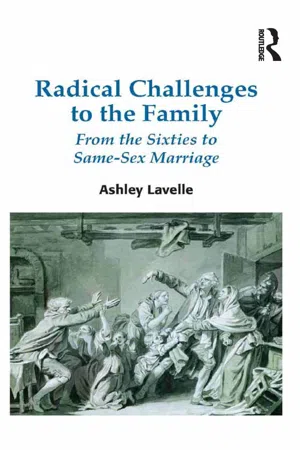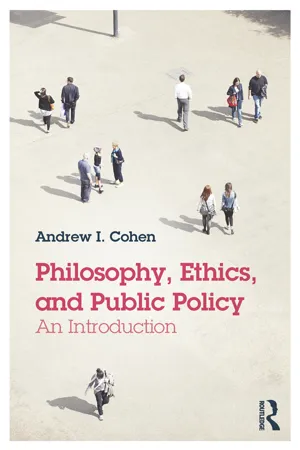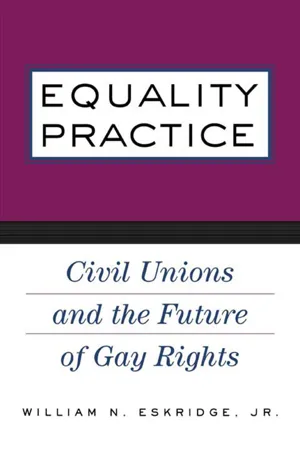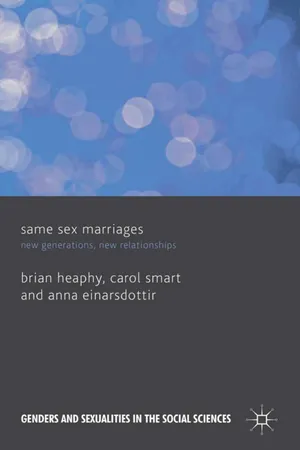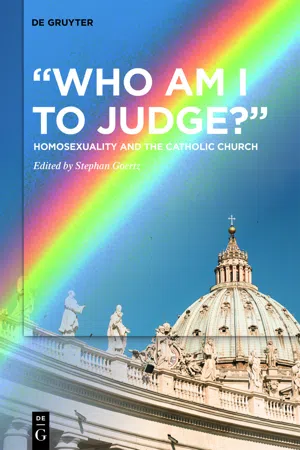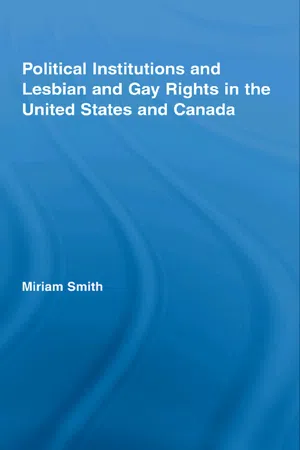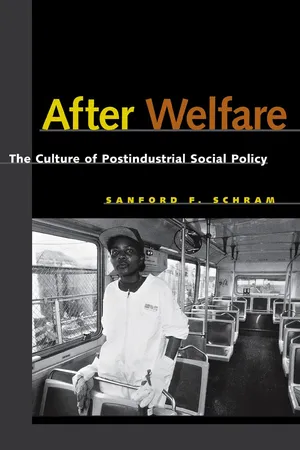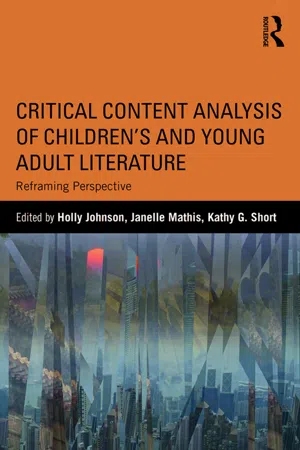Politics & International Relations
Same Sex Marriage
Same-sex marriage refers to the legal union between two individuals of the same gender. It has been a topic of political and social debate, with some countries legalizing it while others have not. Advocates argue that it is a matter of equality and human rights, while opponents often cite religious or traditional beliefs in their opposition.
Written by Perlego with AI-assistance
Related key terms
Related key terms
1 of 4
Related key terms
1 of 3
8 Key excerpts on "Same Sex Marriage"
- eBook - ePub
Radical Challenges to the Family
From the Sixties to Same-Sex Marriage
- Ashley Lavelle(Author)
- 2016(Publication Date)
- Routledge(Publisher)
11 Rainbow Wedding The Politics of Same-Sex Marriage DOI: 10.4324/9781315603445-12 The unprecedented international same-sex marriage rights campaign has taken the world by storm. So successful has it been that, according to a 2013 Pew survey, some 72 per cent of Americans regard same-sex marriage as a fait accompli (cited in Metro 2013, 6). After the US Supreme Court effectively overturned California’s ban on same-sex marriage in June 2013, extending equal marriage rights to a then 13th American state, 1 and underwriting federal recognition of same-sex marriages undertaken in approving States, The New York Times editorialised that ‘the momentum of marriage equality seems unstoppable’ (The New York Times 2013, A30; van Eeden-Moorefield and Alvarez 2015, 57). This was followed in July by legalisation in England and Wales. As of writing, same-sex marriage was legal – or at least would soon be – in more than 20 countries. Notwithstanding the obvious caveat that the vast majority of the close to 200 states in the world are yet to sanction same-sex marriage, there is no doubt about the rapid progress being made. 1 A late-June 2015 Supreme Court ruling effectively extended same-sex marriage to all 50 US states. The full story of this epic struggle is beyond the scope of this book (see Kollman 2013). Instead, our focus is on how it relates to the gay liberation movement that preceded it, and how we should understand the movement in light of the broader criticisms of family and marriage that animated ‘60s rebels. The chapter begins by politically framing the movement. It then traces its historical development, before analysing the increasing support in LGBT communities for same-sex unions - Andrew Cohen(Author)
- 2014(Publication Date)
- Routledge(Publisher)
Of course, not all marriages involve the same specific commitments and the same shared understandings. By marrying, however, partners typically signal to one another and to their community a commitment to some enduring form of mutual care. People seek such relationships as a unique source of special value for themselves and their partners. The controversy here is about whether to restrict such benefits to male/female couples.Context matters. History is marked with institutionalized oppression and violence against gays and lesbians. Indeed, in many countries, being gay is still an offense punishable with imprisonment or death (Human Rights Council, 2011 ). For many gays and lesbians, protecting the opportunity to marry is important as an expression of their equal legal, civic, social, and moral status.The definitional approach
Many discussions of same-sex marriage start by exploring definitions of marriage. After all, it seems we should know what we are talking about before tackling the hard work of exploring appropriate applications of a concept. Perhaps the very idea of marriage can shed some light on whether there can be such a thing as same-sex marriage.Some writers argue that marriage has a fixed meaning that cannot be changed by wishing or legislation. As Maggie Gallagher writes, “Politicians can pass a bill saying a chicken is a duck and that doesn’t make it true. Truth matters” (Gallagher, 2009 ). Critics of same-sex marriage argue that marriage simply is a certain union between a male and a female.This is what John Corvino calls a “definitional objection” (Corvino, 2012 ). This objection basically runs as follows. Marriage is a relationship that is valuable for what it brings about (such as improving the partners and contributing to children’s welfare). Marriage is also good in itself: it involves a special unity of two persons, ordered to a shared biological goal, namely, procreation. The only sort of union that can be directed toward that end is one including only a male and a female; only a male and female pair is capable of becoming a special whole whose activity together can solidify and express their union. (See, for instance, Girgis, 2014- eBook - ePub
Equality Practice
Civil Unions and the Future of Gay Rights
- William N. Eskridge, Jr.(Authors)
- 2013(Publication Date)
- Routledge(Publisher)
CHAPTER ONE ___________________Same-Sex Marriage and the Politics of Sexuality
FOR MOST OF THE TWENTIETH CENTURY , legally recognized same-sex marriage was unthinkable. “Homosexuals” were a despised group, outlaws hunted by the state. The most practical strategy was denial of one's sexual orientation and practices—a lifelong masquerade , as people termed it for most of the century. An open relationship with another person of the same sex would have exposed the masquerade, and applying for a marriage license would have been a ticket to prison. After World War II, homosexuals came to see themselves caught in the dilemma of the “closet”: the secrecy that protected them also suffocated them.1 Some of those who felt this suffocation or who had been pushed out of the closet (usually by the state) objected to their treatment by the state. At first, their horizons were narrow. The early homophile movement was largely limited to a politics of protection: the state engaged in episodic campaigns to protect children and public spaces against homosexuals, who in turn fought to protect their private spaces and subcultural institutions (bars, clubs, journals) from state intrusion. Under such a regime, same-sex marriage was not a realistic goal.This politics began to change in the 1960s. Inspired by the civil rights movement, some homosexuals publicly insisted that the state treat them the same as everyone else. The Stonewall riots of June 1969 stimulated thousands of queer people to come out of their closets and create hundreds of organizations insisting that the state not only get off their backs but assure them equal rights other minorities had achieved. The post-Stonewall “gay rights” movement not only demanded that states repeal sodomy laws, but that states and municipalities adopt new laws prohibiting public and private discrimination on the basis of sexual orientation. Nancy Fraser calls this a politics of recognition , which she distinguishes from a class-based politics of redistribution. As she notes, “Gays and lesbians suffer from heterosexism: the authoritative construction of norms that privilege heterosexuality. … The remedy for the injustice, consequently, is recognition , not redistribution. Overcoming homophobia and heterosexism requires changing the cultural valuations (as well as their legal and practical expressions) that privilege heterosexuality, deny equal respect to gays and lesbians, and refuse to recognize homosexuality as a legitimate way of being sexual.”2 - eBook - ePub
Same Sex Marriages
New Generations, New Relationships
- B. Heaphy, C. Smart, A. Einarsdottir(Authors)
- 2013(Publication Date)
- Palgrave Macmillan(Publisher)
distinctive lesbian and gay ethos of – or approaches to – relating: that heterosexuality and marriage, and the links between them, have remained historically and generationally static. Thus, marriage and heterosexuality are primarily viewed in static institutional terms as ‘givens’, and not in terms of dynamic meanings and practices. Hence, while the creativity and vitality of lesbian and gay relationships are applauded, little credence is given to historical agency as far as heterosexuality is concerned. This undermines the ways in which definitions and practices of marriage have in some contexts become more flexible and open, which partly accounts for why same-sex relationships can be incorporated into marriage.The politics of marriage
Same-sex marriage and the recent proliferation of marriage-like arrangements, along with continuing struggles for and against these, are often seen as representing a critical moment in the history of marriage as an institution (Oerton, 2008). While this can be viewed in negative, positive and ambivalent ways, it cannot be understood in isolation from longer-term and broader developments in the diversification and vitalisation of ordinary ways of relating on the ground. Before discussing this, let us briefly review the current state of affairs with respect to same-sex relationship recognition. Few countries currently afford same-sex couples the opportunity to fully participate in marriage. As of late 2011, those that do include Argentina, Belgium, Canada, Iceland, the Netherlands, Norway, Portugal, South Africa, Spain and Sweden. In addition, same-sex marriages are performed in Mexico City and in six states of the USA. Additionally, marriages are recognised but not performed in countries like Israel and France. As well as a growing number of European states, Australia, Brazil, Mexico, New Zealand and other countries have either nationwide or regional facilities for the recognition of same-sex or cohabiting relationships. Civil unions, civil partnerships and registered cohabitation, which often include exemptions from the automatic rights afforded heterosexual married couples, are the most common forms of legal recognition. To varying degrees they offer some of the legal, symbolic and material advantages associated with marriage, but often with more limited legal status. Same-sex marriage and civil unions are being debated, planned for and - eBook - ePub
"Who Am I to Judge?"
Homosexuality and the Catholic Church
- Stephan Goertz, Stephan Goertz(Authors)
- 2021(Publication Date)
- De Gruyter(Publisher)
Socio-Ethical Challenges
Same-Sex Partnership and Marriage
Konrad Hilpert1 Reconstructing the Socio-Ethical Issue
Two motivational strands intertwine around the issue of same-sex marriage, each with its own long, tumultuous history. One of these is the effort to gain access to marriage as an institutionalized way of life and model of responsibility; the other is the demand for public recognition of the practiced and socially observed behaviors and lifestyles of people oriented toward persons of the same sex as themselves.Both historically and culturally, neither access to institutionalized marriage nor the free choice of a partner and the decision to have children together is as self-evident as it seems to most citizens of liberal constitutional states today. Indeed, for long periods of history, marriage bans existed with regard to criteria such as lineage, economics, or ethnicity. In addition, family associations and interests imposed severe restrictions, which individuals – with all of their wishes and feelings – only rarely managed to oppose with any prospect of success. In isolated cases along the present-day cultural spectrum, marriages may still be arranged by parents or guardians, or require the approval of an official government authority, and coercion may even be employed. Nevertheless, there is a broad consensus, partly based on human rights, that such restrictions can in no way be justified and therefore should not occur. The only legitimate, meaningful restriction is the age of majority, which is concretized in the respective legislation and recognized as the external criterion of marriageability.The struggle for public recognition of same-sex sensibilities, behaviors, and lifestyles has primarily been a campaign against their disqualification as “unnatural,” and thus as a choice for which the subjects were culpable, or as “pathological” – views which had been firmly enculturated for centuries. The social consequences of these outdated perspectives included severe legal restrictions and prohibitions as well as de facto - Miriam Smith(Author)
- 2008(Publication Date)
- Routledge(Publisher)
5 The Emergence of Same-Sex Marriage, 1991–1999By the late 1990s, same-sex marriage had emerged as the dominant “gay rights” issue in national politics in the U.S. and Canada. State courts in the U.S. set the policy agenda by finding in favor of same-sex couples in a series of decisions beginning in Hawai’i in 1993. By 2005 when Canada legalized same-sex civil marriage, American policy outcomes were much more diverse, with marriage available in Massachusetts, civil union available in Vermont (and pending in other states), and domestic partnerships recognized in Hawai’i and other states. Same-sex marriage had been rendered unconstitutional in some state constitutions, banned by statute in other states, and its recognition in federal law had been prohibited through the passage of the federal Defense of Marriage Act (1996), which had also explicitly recognized the right of the states to refuse to recognize same-sex marriages from other states. While Canada legalized same-sex marriage, the U.S. Congress tabled a constitutional amendment to ban it, an amendment supported by President George W. Bush. These divergences show the long-term impact of policy legacies on the definition of this public policy issue in the two contexts, the ongoing impact of institutional differences in shaping policy discourse, political struggles and policy outcomes, and the contrasting dynamics of partisan conflict.While lesbian and gay rights struggles from the late 1960s to the 1990s focused on the rights of the individual, the late 1990s saw a shift of the legal and political terrain from the rights of the individual to the rights of couples and families (Chauncey 2004:94). Yet, the way in which the issue of discrimination against individuals had been resolved (or not) set the parameters for the recognition of the legal rights of same-sex couples. From the modest policy variance of 1969, when homosexuality was decriminalized in Canada, the policy variance between the two cases had been compounded as the U.S. was unable to decriminalize sodomy on a nation-wide basis or offer basic anti-discrimination protection let alone relationship recognition and same-sex marriage. At the same time, these policy challenges had forced the U.S lesbian and gay movement to develop its political skills and resources to an extent unparalleled in Canada (see Fetner forthcoming). Federalism also compounded the complexity of policy change in the U.S. Just as criminal law is allocated to the states in the U.S. and to federal jurisdiction in Canada, so too civil marriage is allocated to federal control in Canada and to state jurisdiction in the U.S. Just as the decriminalization of sodomy proceeded on a state-by-state basis in the U.S., so too policy shifts on same-sex marriage took place in state-by-state battles rather than, as in Canada, by way of a policy change in federal jurisdiction. State constitutions provided openings for opponents of same-sex marriage in the late 1990s and the first decade of the 2000s, just as these constitutional arrangements had provided opportunities for gay rights opponents in Dade County for Anita Bryant in 1977, in Colorado for the proponents of Amendment 2 in 1992, and across many other states where discrimination protections were rolled back. The federal Defense of Marriage Act (DOMA) was signed into law by Bill Clinton in 1996 in response to the first spate of same-sex marriage cases in Hawai’i; DOMAs and state constitutional bans on same-sex marriage were widely diffused through the states between 1996 and 2004.1- eBook - ePub
After Welfare
The Culture of Postindustrial Social Policy
- Sanford F. Schram(Author)
- 2000(Publication Date)
- NYU Press(Publisher)
As a result, federal legislation has defined marriage for purposes of federal law as limited to unions between a man and a woman, preempted state powers to define marriages for purposes of federal law, and interfered with the process by which one state recognizes the marriages of another. In the end, after intense political debate and extensive campaigning by fundamentalist groups from outside the state, the voters of the state of Hawai’i passed a constitutional amendment limiting marriage to a man and a woman and the state legislature enacted a limited domestic partnership law. 1 In this chapter, I argue that in addition to the rights of gays and lesbians, DOMA raises the issue of how the family is the assumed basis for social policy. In the process, the question of Same Sex Marriage has highlighted the problem of federalism. The analysis below details how in both cases a politics of metaphors is at work to decide the terms of effective participation in the public sphere. I suggest that this use of metaphors reflects a “politics of incorporation” whereby marginalized persons or places are shown to be not really different from those that are legitimated. This politics of incorporation uses what J. M. Balkin calls “cultural software.” 2 Cultural software refers to the way ideology articulates affinities between the familiar and the unknown by using existing metaphors and models available in society. This ideological process makes ostensibly different things alike. In fact classic civil rights strategy has been to use the available “cultural software” so that the marginalized are incorporated into the public sphere by showing how they are not really different from those who have already been included - eBook - ePub
Critical Content Analysis of Children's and Young Adult Literature
Reframing Perspective
- Holly Johnson, Janelle Mathis, Kathy G. Short, Holly Johnson, Janelle Mathis, Kathy G. Short(Authors)
- 2016(Publication Date)
- Routledge(Publisher)
Marriage equality advocates have argued that marriage is a right, not a privilege in the United States. However, the fight for marriage equality was a difficult process, with multiple roadblocks and setbacks. Despite the Supreme Court decision, the fight continues in other forms as some states and localities introduce legislation that allows government officials and commercial vendors who oppose Same Sex Marriage to opt out of providing services. However, Same Sex Marriage is now legal in the United States, and social acceptance is growing as new kinds of family structures are legitimated by social custom and legal recognition. While stable and lasting same sex relationships have existed for many years and were increasingly accepted in many parts of the country even before the Supreme Court decision, legal recognition opens the door to a variety of legal and economic benefits.Although there continues to be resistance to Same Sex Marriages by certain cultural, political, and religious groups, acceptance is increasingly evident. Today’s children will experience these expanded family structures as both normal and equal to traditional heterosexual relationships. One way that children can learn about these expanded possibilities is through children’s books. Books that depict Same Sex Marriages in authentic, positive ways are important for children who have same sex parents and for children who are themselves lesbian or gay. In addition, these books provide a resource for all children who are learning about the many ways of being in this world. However, books can also reinforce negative or limited perspectives and perpetuate the status quo. Children’s book publishing has struggled with issues of diversity and representation of all kinds (Horning, 2014), with increasing numbers of people wondering why certain groups are privileged with abundant representation while others are all but invisible. In this chapter I explore how these issues play out in children’s picture storybooks featuring Same Sex Marriage.Theoretical Frame
Intersectionality and privilege theories are theoretical frames that are useful in examining picture storybooks where Same Sex Marriage is a central part of the plotline. Intersectionality arose from black feminist theory out of a recognition that feminist thinking of the time often privileged the issues and experiences of white, middle-class women, while ignoring or negating the experiences of women of color (Berger & Guidroz, 2009). Kimberlé Crenshaw, a legal scholar working with black feminist issues, is often credited with coining the term ‘intersectional’ as a label for an approach to thinking that recognizes the limitations inherent in a examinations of single aspects of identity (Grzanka, 2014a).
Index pages curate the most relevant extracts from our library of academic textbooks. They’ve been created using an in-house natural language model (NLM), each adding context and meaning to key research topics.
Explore more topic indexes
Explore more topic indexes
1 of 6
Explore more topic indexes
1 of 4
